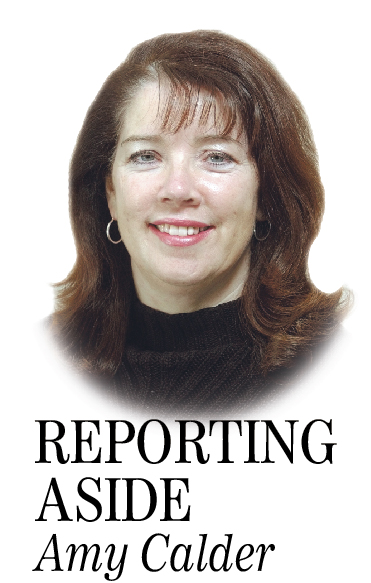WHEN YOU READ this, it may be the first day of spring.
Hard to believe, as we sit here on Tuesday, snow swirling outside the window, city trucks rumbling down the street trying to clear roads as vehicles are parked haphazardly here and there.
Winter is rough for us northeasterners, but not like they used to be.
I grew up in an old farmhouse in the Skowhegan countryside, which isn’t country anymore, as so many houses and churches and businesses have been built since in the pastures and fields all around.
I don’t believe our house was insulated in the late 1950s and early ’60s and the large bedroom upstairs I shared with my two sisters had walls so thin you could poke an elbow through to the rafters if you shoved hard enough.
On frigid winter mornings as we climbed out of bed, we could see the breath come out of our mouths in great white puffs.
While we slept well in our flannel pajamas and flannel sheets and wool blankets piled high, the minute our feet struck the floor we flew down the stairs to the oil furnace grate on the floor near the living room.
There, we hovered over the grate, as the hot air blew up and out to the rest of the house.
In the kitchen, we had a wood stove, too, which kept us toasty warm on icy winter mornings. When we came in from playing outside, we tossed our frozen mittens against that stove, which emitted a sizzling sound and a burning wool smell that comes back to me in a most poignant way if I close my eyes and place myself back there.
Winters were dark, the evenings were short and we hated to get out of bed in the morning to go to school.
“It’s ten past seven!” my mother would call up the stairs, alerting us it was time to eat.
Oatmeal, cream of wheat or corn meal sprinkled with sugar and dribbled with whole milk from a glass jug was the winter fare in our house. There was always toast and butter with homemade crabapple or strawberry jam and always a tiny glass of orange juice.
Occasionally, if we all got up late at the same time, it was a scramble for the bathroom and none of us had time to eat a proper meal at the kitchen table. We’d fly out the door after the bus beeped its horn. Embarrassed, we’d climb the bus steps, single-file, to snorts and laughter from neighbors with whom we played baseball in summer.
More embarrassing was that my father, who refused to let us out of his sight without nourishment, chased us to the bus with a tray of juice glasses, shaming us into drinking up before we stepped foot on the bus.
One day in the third grade, as we tore into the classroom to remove our winter parkas and ski pants, I was mortified to look down and see that I was wearing my pajama top under my coat. Never again did I leave the house without inspecting my attire; I had learned a lesson the hard way.
One of the winter perks while growing up in Skowhegan was the recreation department’s ski program at Eaton Mountain. On cold afternoons we’d come home from school, do our homework, eat supper, don our ski gear and head downtown to the municipal building to catch the bus to the mountain for night skiing.
In those days we had long Head or K2 skis with clunky ski boots and bindings that, all told, weighed a ton. We hauled our skis to the back of the bus and lay them crosswise over the seats where they all crashed into each other on the 6-mile ride to the mountain.
We skied for what seemed like hours, sometimes on perfect powder and sometimes on near ice, having ascended the mountain via chair lift, T-bar or rope tow, the latter of which burned holes in the mittens our mother made for us every year.
Sailing down the mountain, carefree and fearless under the lights, was pure bliss. Eating french fries and sipping hot cocoa at the snack bar inside the lodge during breaks was heaven, especially after I discovered the joys of dousing the fries in white vinegar from a glass shaker before salting them. It was a taste I craved throughout my high school years whenever I skied nights.
Afterward, we’d go home, exhausted and bleary-eyed, collapse into bed and sleep the deep, satisfying slumber that comes from squeezing every shred of fun out of winter.
Why, as we grow older, we tend to regard winter months as drudgery, I don’t know, but it likely has something to do with the work associated with shoveling snow or the hit we take to our pocketbooks to have it plowed. At some point, the magic of winter left us, likely as we transitioned from school and play to work and worry.
But each year, just when we tire of the dark and cold, March 20 rolls around and it’s time to resurrect the seed catalogs.
And while spring can be a trial in itself, we all know what follows — and boy, is it ever worth the wait.
Amy Calder has been a Morning Sentinel reporter for 29 years. Her column appears here Mondays. She may be reached at acalder@centralmaine.com. For previous Reporting Aside columns, go to centralmaine.com.
Send questions/comments to the editors.



Comments are no longer available on this story